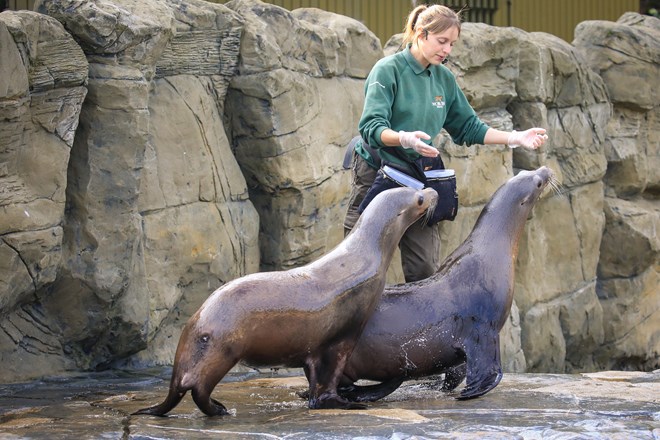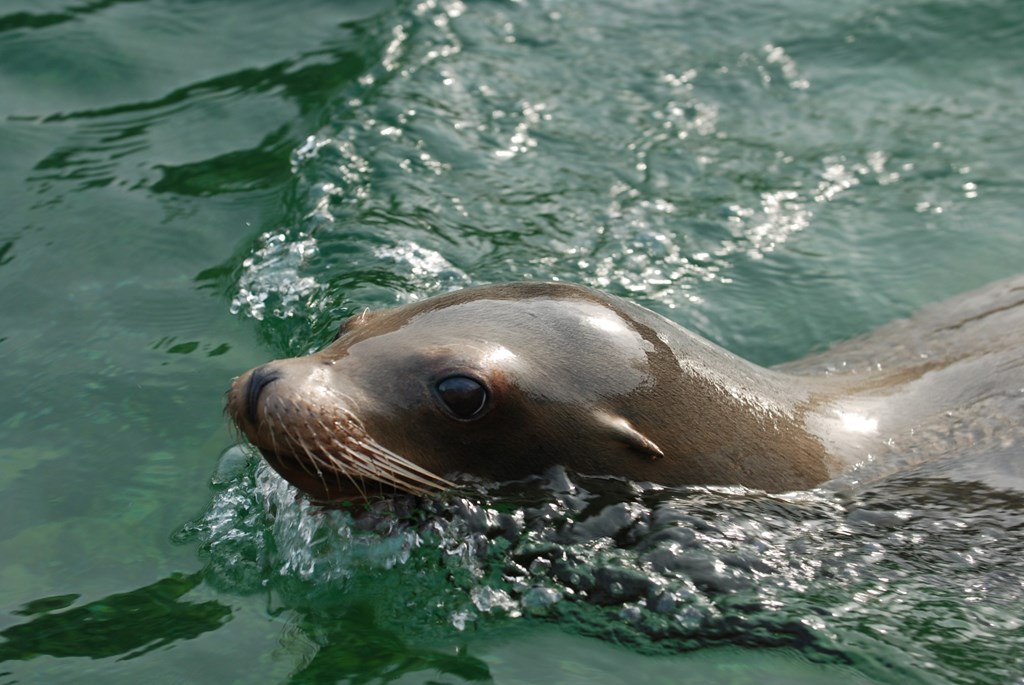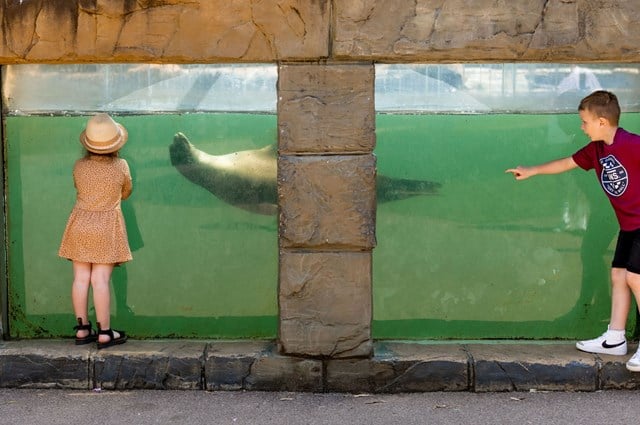
Overview
The Californian Sea Lion can be found in California, as its name suggests, but are very widespread and can also be found along the West coast of America, reaching as far North as Alaska and as far South as Mexico.
The ‘Lion’ part of their name comes from the appearance of the adult males of some sea lion species; they have a large mane of fur around their neck giving them the appearance of a lion, and their loud roaring calls.
.

All about us
| Distribution: | West coast of America, Alaska to Mexico |
|---|---|
| Habitat: | Rocky coastal areas, beaches |
| Height: | Males 2.4m, females up to 2m |
| Weight: | Males 400kg, Females 120kg |
| Lifespan: | Wild: 15-24 years. Captivity 20-30 years |
| Threats: | Drowning in fishing nets, disease, poisoning, pollution and toxic phytoplankton blooms. |
Scientific name: Zalophus californianus
Woburn Safari Park is home to two female sea lions; Kira and Leoni.
The sea lions can be seen in the Foot Safari where they have access to their outdoor pools at Sea Lion Beach and their six indoor pools at Sea Lion Cove. Check out the timetable to get to know them better in their daily demos!

Californian sea lion facts
- Physical features
- Diet
- Social structure and communication
- Husbandry and enrichment
- Threats and conservation
The male and female differ significantly in size, males can weigh up to four times that of females. Females are usually no longer than 2m, and weigh up to 120kg, whereas males can be up to 2.4m in length and up to 400kg.
The male has a large sagittal crest, a bony plate protruding from the skull, which gives them a very pronounced forehead. This crest only develops once they have reached sexual maturity, at the age of around four to five.
Although they do not look like it, Sea Lions are covered in a coating of thick fur. When wet this coat appears a dark brown or grey colour, and smooth, however once a Sea Lion is on land and dry it becomes a light grey to orange colour. Males are usually darker in colour than females, and can have a small mane of fur around their neck, although this is less pronounced than in other sea lion species.
The sea lion is covered in a thick layer of blubber under its skin to keep it warm when in the water, but they can self regulate their body temperature by holding their flippers out of the water where the blood vessels close to the skin allow them to cool down.
California sea lions swim using their fore-flippers and are particularly agile on land as they are able to control their hind flippers independently. They can swim at speeds of up to 25mph and run faster than a human.
When diving deep, California sea lions slow their heart rates to allow them to remain underwater longer. The longest dive recorded was nearly 300m, although the average dive is between 26 to 98m. The longest dive lasted just under ten minutes, but will usually be no more than two minutes.
Sea lions have large eyes, giving them good vision both below and above the water, but for hunting in dark murky waters their large whiskers, or vibrissae, are a vital tool for feeling vibrations in the water and locating food.
California sea lions will eat over fifty different species of fish, including rockfish, flatfish, hake, salmon, mackerel and pacific whiting. They will also feed on some cephalopod species such as octopus and squid. They will frequently feed on species favoured by commercial fishing, causing conflict with fishermen.
Although a very social species, which spends most time on land in large groups, they will tend to feed individually or in small groups, unless there is an overabundance of food present.
During the breeding season, around May to June, a male, also known as a bull, will fight for a territory on a beach. If successful he will then guard this territory and maintain its boundaries with physical displays and frequent vocal displays. He can hold this territory for up to 45 days if he is not out competed by another male. During this time females will come onto land to give birth, usually to a single pup, then at around 28 days after birth they are ready to mate again. The breeding season ends around August, when they males migrate north and the females and juveniles disperse around the breeding grounds.
Mothers will spend the first week after birth with their pup constantly feeding, and then begin hunting trips to sea for two or three days, with bouts of two or three days feeding their pup on land in between. At around ten to twelve months the pup will be weaned.
Communication is vital for the mother and pup bond, with a pup being able to recognise its mother in a group of hundreds just from her call. It is also vital for territorial bulls guarding their part of beach to bark constantly.
This highly social and intelligent species is often found in zoos and aquariums around the world performing in demonstrations. Their high level of intelligence has also made them a valuable resource for the US Navy, who utilise them along side dolphins to mark and retrieve objects, and alert for intruders.
Here at Woburn we use this intelligence to train them for several different reasons. We train them to allow us to perform basic husbandry and health checks, which is the most important thing we can do. Our sea lions cooperate with us to let us check their teeth and inside their mouth, to check flippers, to allow us to feel their whole body, and even to allow scans and tests without sedation. These behaviours allow to keep a close check on their health in a completely stress free way.
The sea lions also take part in our public demonstrations, showing off their mental capabilities, using the list of over one hundred commands they have learned, as well as showing off their physical skills, swimming, jumping, and running amongst other things. This provides a great opportunity for exercise, both on land and in water, and keeps them physically fit, as well as mentally enriching them. It also allows us to promote natural behaviours, such as porpiosing, a behaviour which allows wild Sea Lions to escape predators, or move faster, by diving in and out of the water at speed.
When they are not working with us in demonstrations they can be found in their deep outside pool, where they act naturally as a group swimming and diving together, or sleeping on the rocky beach as they would in the wild.
Adult sea lions are rarely predated upon, however the vulnerable pups which cannot swim for the first few weeks of life are often preyed upon by coyotes and feral dogs on land, and once learning to swim, by Great White Sharks and Killer Whales the water.
In the 19th and 20th century sea lion were hunted extensively for commercial purposes, such as blubber, and fur. Their hunting was banned between 1969 and 1972, and since then population numbers have recovered well. Population estimates now suggest over 250,000 Californian Sea Lions are currently living on the West coast of America. They do however face other human threats in the form of fishing nets, as they tend to feed on species also used in commercial fishing, they will often be caught in fishing nets and drown.
Other threats include disease, poisoning, pollution and toxic phytoplankton blooms. They can be adversely affected by El Niño, a natural phenomenon which happens every four to twelve years causing the warming of the sea around the coast of South America, causing die offs of fish, and so a shortage in food supply and increased mortality for the Sea Lion.
The California sea lion is currently classified as Least Concern on the IUCN Red List, and at present the population is stable. As long as there is enough food, and some level of protection remains, it is thought that there is no immediate threat to the survival of the California sea lion.
They are the commonly used in demonstrations in zoos and aquariums around the world, playing a vital role in educating visitors, and highlighting issues such as pollution and overfishing. So even though they themselves are not a threatened species they can play a part to help those who are.
This species is also part of an ESB, European studbook, meaning there is a keeper responsible for collecting all the data on births, deaths, and transfers for this species in Europe, and producing a studbook. They can also be asked for recommendations for breeding or transfers. Through their data collection they can assess how well a species is doing in captivity and if it needs to be managed more intensively as an EEP species.

